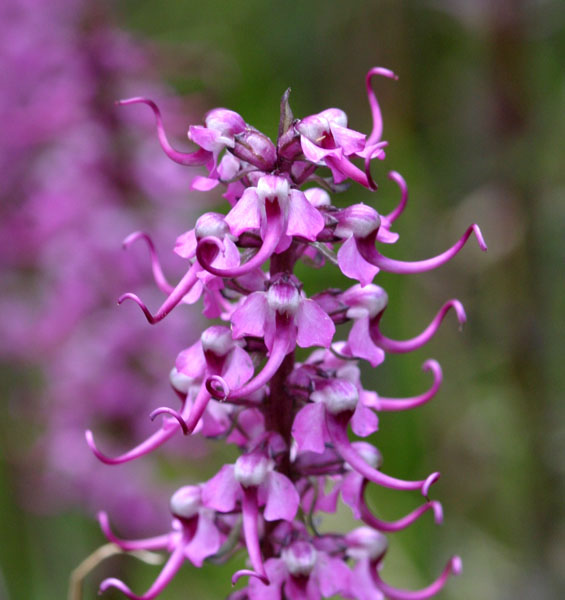Fulgurites and pine nuts...
On one of my family's epic camping trips “out west” – one of the earlier ones, I think – we stopped to camp in Great Sand Dunes National Park, in south-central Colorado. The whole family was along: mom and dad, my siblings Holly, Scott, and Mark, and me. We must have been there at least a couple of days, because we had time for two distinctly different little adventures.
If you've never been to Great Sand Dunes National Park, you might be completely unaware of it, as it doesn't have the popularity or cachet of other great western parks like Yellowstone, Zion, or Yosemite. It's a weird place, full of things to marvel about, not least of which are the giant sand dunes themselves. The satellite photo at left shows an area roughly 8 miles wide, with the great dunes in the middle. To the east (the right) there's a mountain range which is actually the source of the dunes – they form a wall that causes the wind to slow down and drop its load of sand and dust.
In the visitor center for the park, we learned about the existence of fulgurites, something none of us had ever heard of before. In the great photo at right (not mine!), you see a relatively small one. They're hollow tubes of fused quartz (sand particles) made when lightning strikes a sand dune. The park, with its giant sand dunes, has thousands of fulgurites form every year. We talked with a ranger who encouraged us to look for them, and told us that on the surface they just looked like a little frozen patch of sand – so they were challenging to spot. Below the surface of the dune they could extend many feet – the biggest ones ever found were something like 40 feet long!
So some of us set out to climb one of the sand dunes and look around on the top of it for evidence of fulgurites. I remember my dad, Scott and I; it's entirely possible that Holly was along as well. I think Mark was probably too young. Climbing those dunes was really tough work, even though we were all hikers – the soft sand made footing challenging, and we'd often slip down almost as far as we climbed.
I have a crystalline memory of that climb: my dad, outlined against the sky above me, on the off-white dunes, laughing and horsing around with us. We were pushing each other back down (which didn't make the climb any easier!), shouting at each other, and all of us laughing so hard we had trouble getting enough air to breathe. Pure, simple, and innocent fun...
We finally did get to the top of a dune, and searched around for the top of a fulgurite. And we found one, albeit a little tiny one, perhaps 10 inches long and a half inch in diameter, a strange and alien-looking thing. I've no idea what happened to that.
The other adventure we had at Great Sand Dunes was of the botanical kind. To the east of the road to the campground, the mountains rose quickly. On the flanks of those mountains the pinyon pines were abundant (my dad knew this from his research). There are several pinyon species; these were Pinus edulis (the Colorado pinyon), which my dad knew were particularly good eating.
In the years since then, I've collected (and eaten!) pinyon pine nuts (the seeds within the cones) many times; pinyons are very common near where I live. But that little trip was the first time we kids had ever looked for them or eaten them, and we weren't entirely sure that my dad wasn't playing tricks with us. Eat a pine cone? That didn't seem very likely. But not far into our walk, my dad spotted some specimens, and we went on the hunt for cones that the jays had not yet eaten (large flocks of Pinyon jays, specialists in pinyon nuts, were all around us). This turned out to be well within the capabilities of little kids like us, and soon we were munching handfuls of pinyon nuts at a time. We also collected a bag full of them to take back to my mom.
My dad was here, there, and everywhere as we collected those nuts. Somehow he kept track of us all (I'm pretty sure that Holly, Scott, and I were on that adventure), helped us all identify the right kind of tree, the cones that still had nuts, and how to extract the nuts (the eating part we had under control :). Somehow he also found moments to gaze around at the beautiful scenery, explain to us about any random thing we asked about (lots! this was all new to us), and to crawl around looking at the various trees and shrubs there that were interesting to him. This was actually completely typical for him on one of our hikes, but for whatever reason the memory of it is clearer for me in this instance than in most others. If I close my eyes, I can still hear the sounds of the pinyon-juniper country (especially those jays!), smell the then-new, now-familiar smells of the American desert (especially sage and pine), and see my dad, shepherding his little flock on another of many little adventures...
Saturday, December 7, 2013
Pater: fulgurites and pine nuts...
Pater: fulgurites and pine nuts... At right is a nice example of “elephant’s head” flower (Pedicularis groenlandica) that my dad, Debbie, and I enjoyed in Corkscrew Gulch, above Silverton in the San Juan Mountains of Colorado, July 2005. These often could be found in the same wet places that one of his other favorites (Parry's primrose) could be found, so we were always searching for the two of them...
Subscribe to:
Post Comments (Atom)




No comments:
Post a Comment